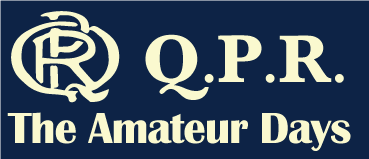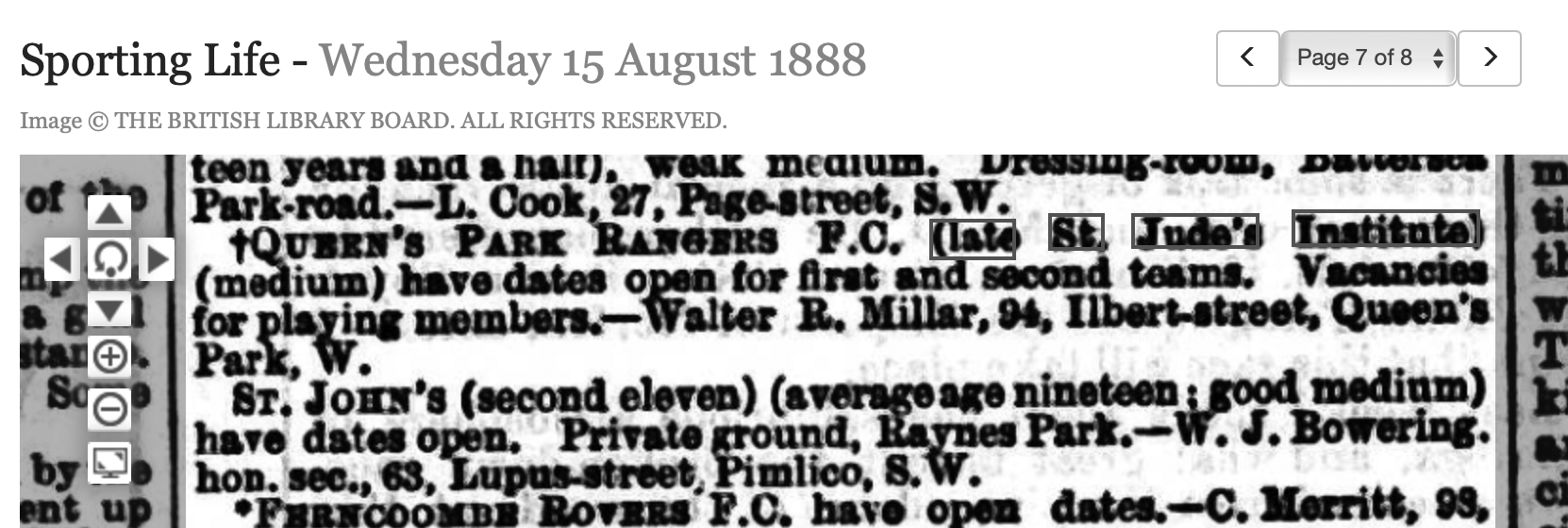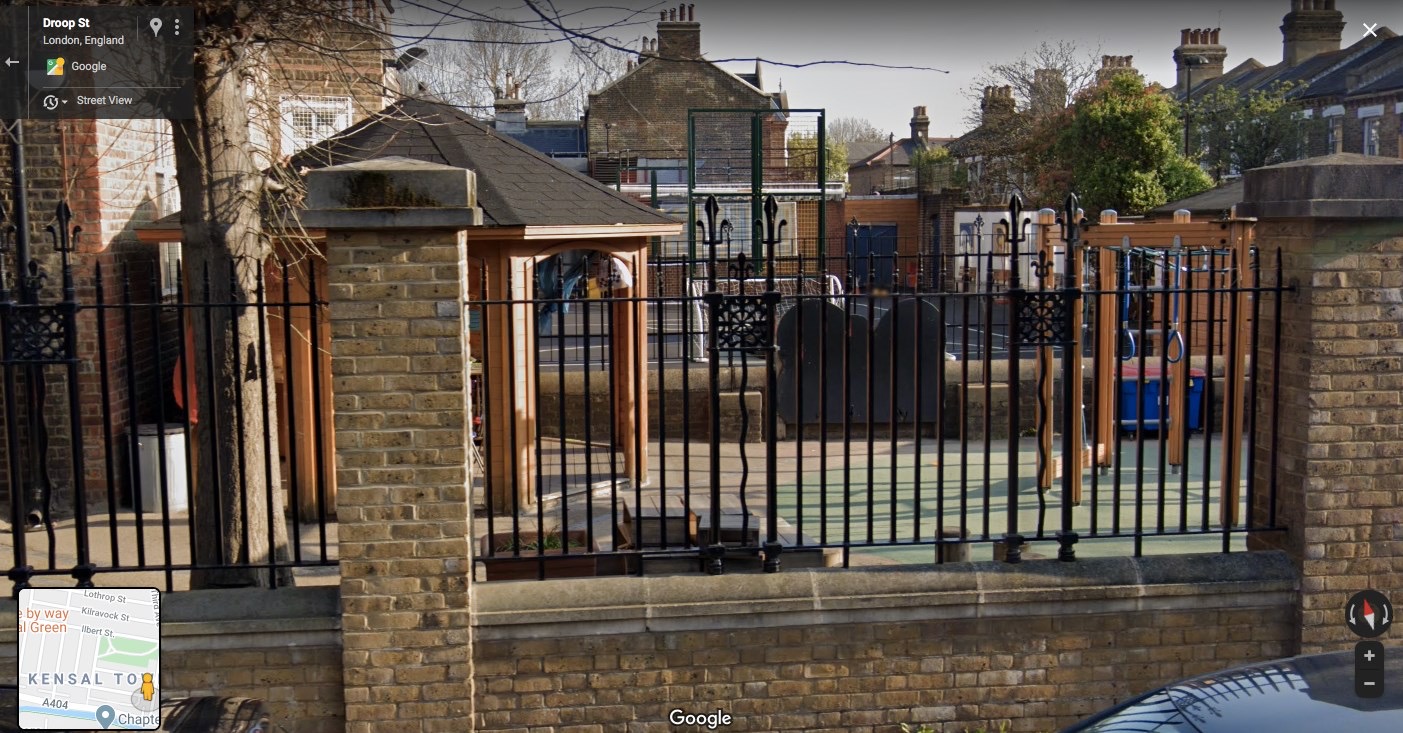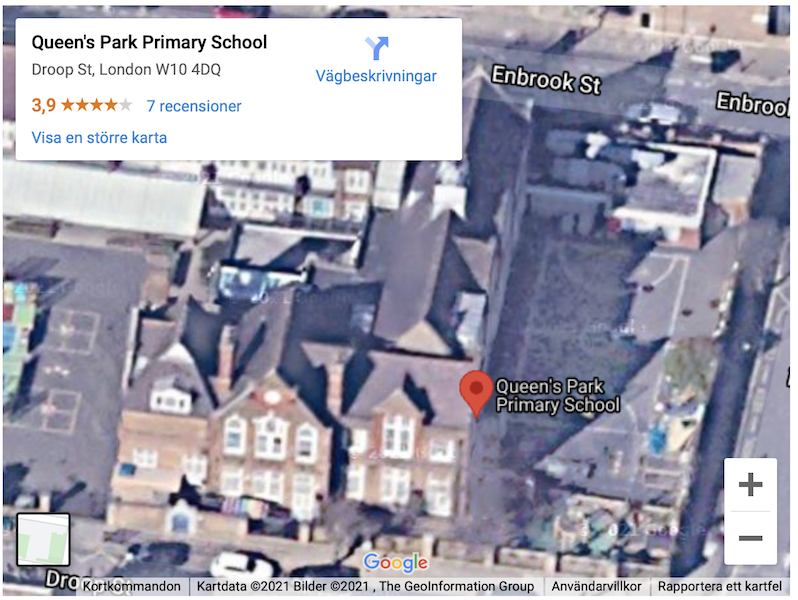| The Origin: Where and When did the club start and by Whom? |
| First, I present the sources. Here I only comment on independance and inaccuracies in the text. Next, I discuss what might be the most reasonable conclusion. |
| Formation of the club at St Jude's Institute: 1885 / 1884. |
The Official History of Queen’s Park Rangers. Reg Hayter 1948

Fig 3a
 Fig 3b Fig 3b
About the source
Reg Hayter was a well known football journalist who had written a lot of club histories.The main sources for the oldiest history was Club Director Wodehouse Sr, who had been told by his father Wodehouse Sr.
Independent source
The Wodehouse part is unique but he has also mixed it with Wood 1905 Fig 4 and Club Handbook 1899 Fig 5.
Outright inaccuracies
Boys Brigade had never been at St Jude's Church. Boys Brigade was associated with the free churces and not Church of England. Mail from Boys Brigade London 2021
Gordon Young did not start the club at St Judes Church. He was appointed as Curator, December 1886 and served until spring 1888. Fig 10
The Gordon Young story is derived from Woods history. Compare "With the hearty co-operation of the Rev. Gordon Young, himself the club's dashing forward...", from Hayter (Fig 1b), with "with the hearty co-operation of the Rev. Gordon Young, a club was formed", from Wood
Fig 4.
| The Book of football: Queen's Park Rangers. Club secretary W. L Wood 1906.
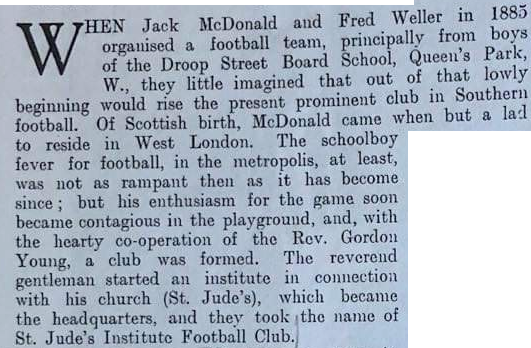
Fig 4a
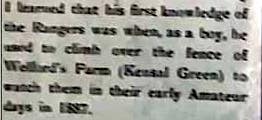
Fig 4b. Interview with Wood in the program for his 1921 benefit match against Chelsea. Interesting to note that he calls the ground Welfords Farm when in his history it is called Welfords Field. Welfords Home Farm is the correct name. Typo?
About the source
W. L. Wood was born in September 1870 in Paddington and in 1881 was living at Edbrooke Road, St Peters Park (Maida Hill), Paddington. By 1891 Wood had moved to Ashmore Road, within St Jude's parish. He probably lived there also in 1887 when he started following the club by jumping over the fence to Welford's farm.
Independent source
The history is more detailed than Handbook 1899 but it's clear that he also has used Handbook 1899 as a model.
Outright inaccuracies
Gordon Young did not start the club at St Judes Church. He was appointed as Curator, December 1886 and served until spring 1888.
The relatively late connection to the club can explain some shortcomings in the historical description before 1887.The text before 1885 appears to be a simplified version of the text from the handbook 1899.
|
| Formation of the club at the school 1882 - 1885
. |
History of Queen’s Park Rangers. Handbook 1899.
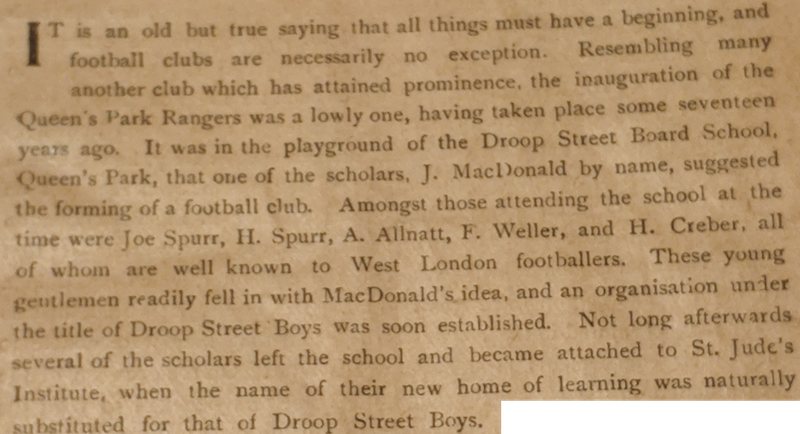 Fig 5 Fig 5
About the source
The history is proberly written by the Editor J.H. Roberts. The Facts for the history was collected by a group of former player. H. G. Teagle, Hiscox, McKenzie and Webb. Teagle had been captian 1892-1897. He had also sometimes served as Club Secretatry. He was married to a sister to the Spurrs brothers who had been in the club since early matches at the schools playground.
Independent source
This is the first history and therefore totaly indenpendent.
Outright inaccuracies
Ouside the clip above is a statement of name change to QPR 1886. The correct year is 1888. But it could be correct in some way. More about this in next chapter: "Complicated Merger Issue"
| Letter to Letter by C. I Young. Home Programme, West Ham United 1973. Part 1 of the letter.
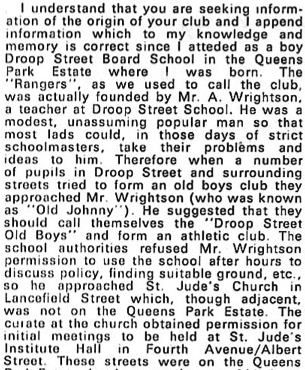
Fig 6. Letter to Letter by C. J. Young. Part 1 of the letter.
About the source
The letter was written by C. J. Young. He was an early supporter of the club. It could have been written years before the publication date 1973. The club was asking the fans about history in both late 1950s and in the 1960s.
Independent source
There are many unique information that is partly confirmed by other sources but is still obviously independent
Outright inaccuracies
Nothing that can directly be disproved
|
John Wrightson retired, Acton Gazette, 1923.

Fig 7
About the source
This is a newsclip for the retierd gathering for John Wrighton.
Independent source
Yes
Outright inaccuracies
None
E. W. Bottle retired, West London Observer, 1940.
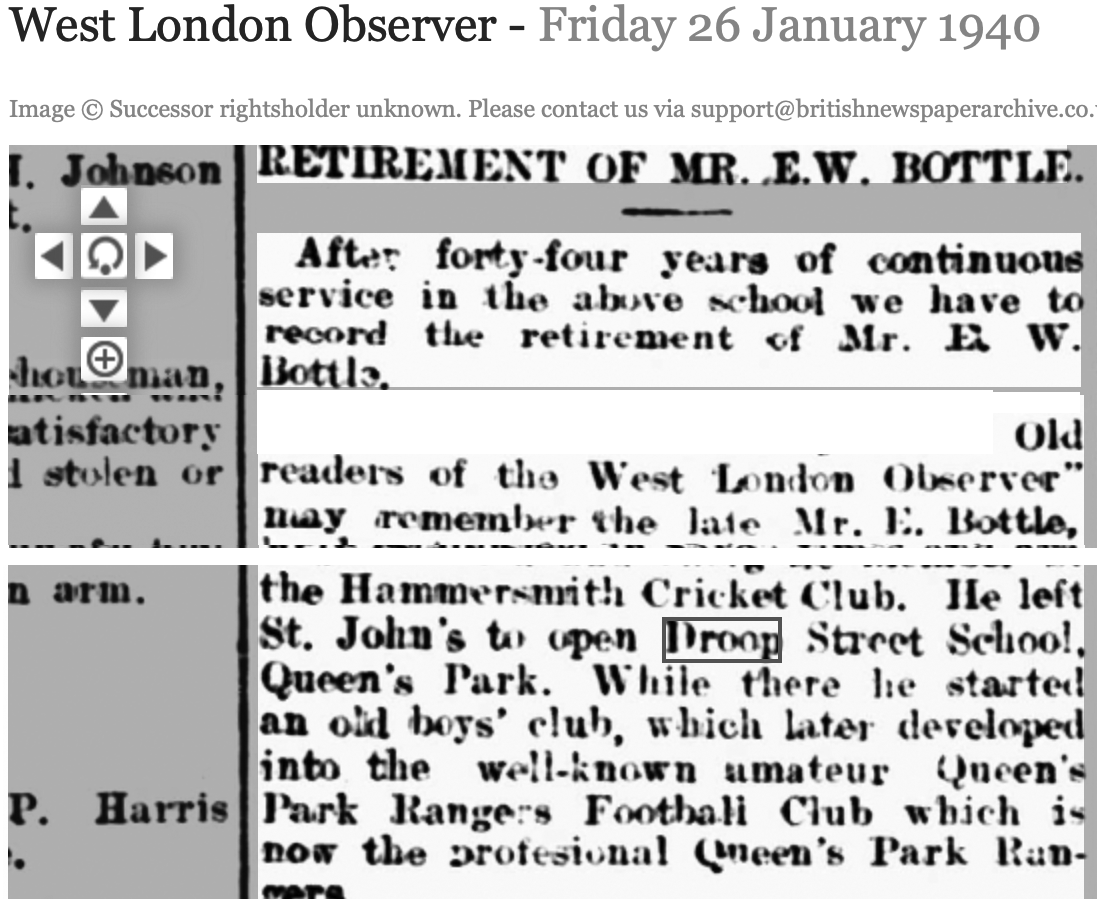
Fig 9
About The Source
This is a newsclip for the retierd gathering for E.W Bottle.
His father was
E Bottle who had been the Principle of Droop Street School.
Independent source
Probarly
Outright inaccuracies
There is a opposite from from the letter by C. I Young Fig 6. that the school management counteract the club which therefore turned to the church.
| 50 Years of Football. Bushranger. Acton Gazette 1935
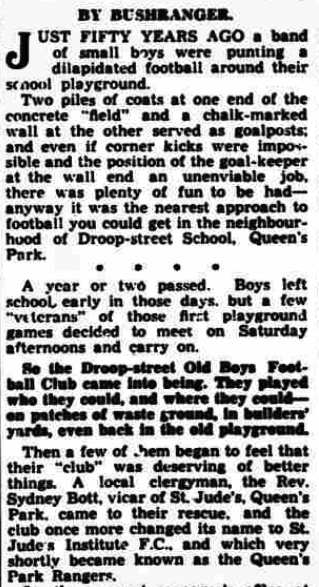
Fig 8
About the source
Bushranger is an unidentified Journalist who writes for several newspapers.
Independent source
There are a lot of unique details that complement other sources.
Outright inaccuracies
None.
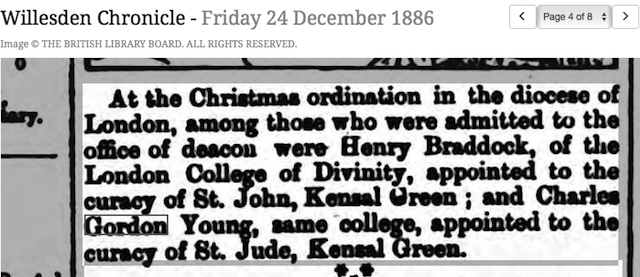
Fig 10. Gordon Young admitted to the curacy of St Jude's Church.
|
| Conclusions about the place |
Current history states that St Jude's Institute FC was started in 1885 by St Jude's Church with boys from Droop Street School. This information comes from Hayter's history 1948, which in turn took the information from Wood's history 1905. He has also borrowed the exact wording: "With the hearty co-operation of the Rev. Gordon Young.."
Woods had been a supporter of the club in his youth and it should have been in 1887 that in his own words "jumped over the fence to Welfords Farm".Fig 4b, Fig 13.
One problem with his history is that he has stated the wrong Reverend for the founding of the club, namely Gordon Young. Gordon Young was appointed as a Curator for the church in December 1886, Fig 10. Gordon Young is included in a balance sheet as a lender so he was certainly very involved in football during 1887 and the Springtime of 1888, before taking up a post as Vicar of Chipstead.
Figure 9, to the right shows that Vicar Sidney Bott ran the club. A decision was made in 1886 to improve St Judes Institute. The decision includes all of the Institutes sporting activities should merge into a single athletic club. It should be named St Jude's Institute Athletic Club.
Sydney Bott is however mentioned in Bushrangers history Fig 9. Busranger also claims the first name was: Droop Street Old Boys FC.
Wood's statement that the club was started by St Jude's Church stands alone against five independent sources who claims that the first club was started by the former school pupils with assistance by Teacher John Wrightson and the club was named: Droop Street Old Boys FC:
-
Handbook 1899. Oldiest source with the facts from older players.Fig 5
- Bushranger. 50 yesrs of History, 1935. Fig 8
⁃ Letter to Letter, by C I Young, 1973. Fig 6 and 11
⁃ Celebration of John Wrightson, 1923. Fig 7 and 11
⁃ Remembering of Principle E. Bottle, 1940. Fig 9
It is quite clear that Wood's history is not reliable for the very oldest part, before 1887, when he saw his first match. 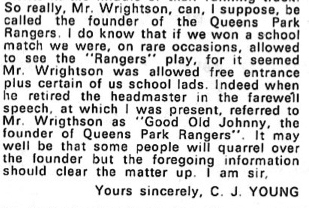 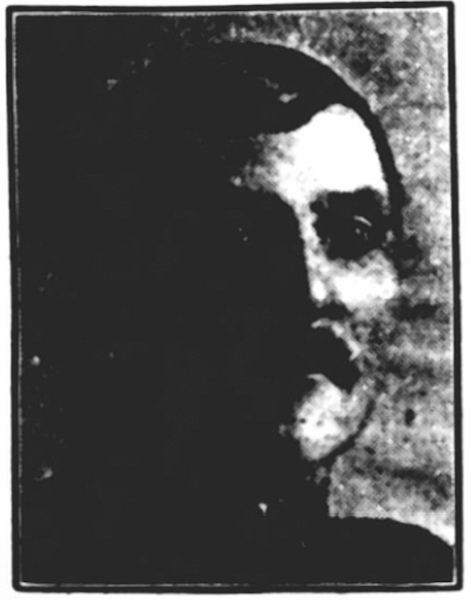
Fig 11. Letter to Letter by C. J. Young. Part 3 of the letter.
Celebration of Teacher John Wrightson as the true founder of Queen's Park Rangers .The value of this notice is strong as the gathering is also mentioned in a news note. Fig 9.
Fig 11b. Photo of John Wrightson 1923.
| 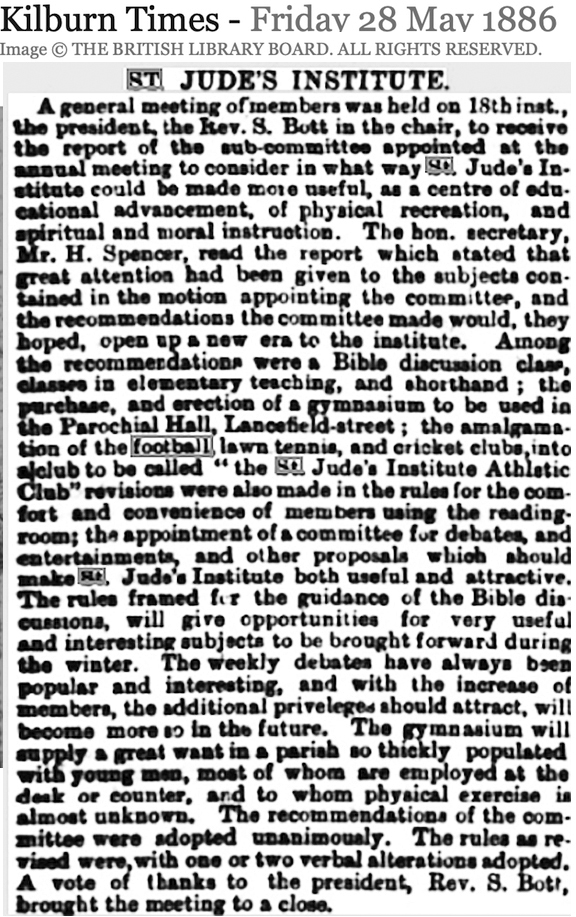
Fig 12. St Judes Institute Athletic Club.
|
| Conclusions about the formation year |
In the historians there are two years that can be set against each othe, either 1885 or 1882. Nowadays 1884 is also used instead of 1885. I have not been able to find out where 1884 comes from. It's still pretty similar anaway.
The year 1885 comes from Wood's history and then refers to St. Jude's Institute, which had been founded by the church Fig 4. The year has also been used by Bushranger Fig 8, as the year the club was formed in the school grounds or a few years after leaving school. The description is unclear but it refers to the club Droop Street Old Boys FC.
1882 comes from the history of Handbook 1899 and refers to Droop Street Boys FC which was formed at the school playground. So, according to this history, it is not an Old Boys' club of former school boys without a regular boys' club.
There are no more sources for the year. To evaluate the year, one needs to examine the age of the boys. In the 1880s, Compulsory schooling was 10 years, which could be extended to 12 years. Of the oldest team, seven players are known namely: John McDonald, Henry Spurr, Joe Spurr, Albin Allnatt, Frank Weller and Henry Creber.
|
A formation year of 1885 works poorly as the founder players as McDonald should have left the school already in 1880-1881. Fig 13. All historians talk about a continuous from school to club, not a 4-5 year break until the club was formed. 4 - 5 years are also very long time for youth people. At 1885 the boys were on the way to grow up. The avarage age was then about 17 years. The year 1885 is not correct as more of the earliest history by Wood.
By this reasoning, the year 1885 is impossible. Woods, the author was 16-17 years old when he climb the fence at Welfords Farm, Before he lived in St Peter's Park (Maida Hill). Paddington. His history has a lack of info for the earliest years; The clubs first name, wrong priest who helped the club, Gordon Young instead of Sydney Bott. Also the story of Fred Weller could not been entirly correct. He didn't attend the school. He was from Wolwerton, Berkshire and was later attached to the club. It's possible he was responsible for the spring travel the club did make to Wolverton in the first halves of th 1890th
A formation year 1882, as described in the Handbook of 1899, is more suitable as it's just a year after the the first mentioned players had left school.
There is a problem with the year 1882 and the name Droop Street Old Boys, namely that the school was called D Street School at that time. If the club was founded in 1884, it would be fucntion but it still would give a too big gap. It is possible that there was a D Street Old Boys first as was changed when the school changed name 1884 and the first name never had been used in any historian.
| 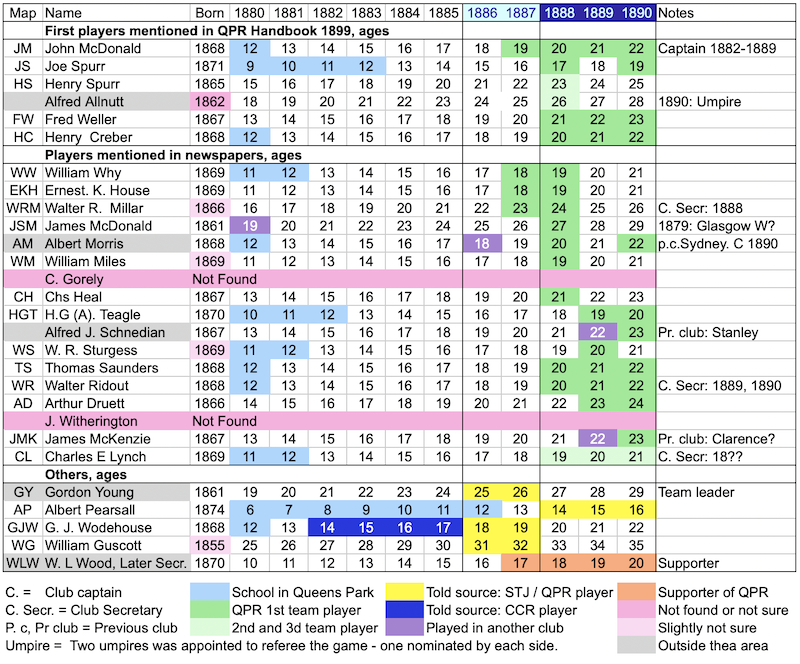
Fig 13. The first players and their age and first recorded matches
Blue color in the table shows school attendance up to 12 years. and the yellow color when they are 13 years old. Compulsory schooling was 10 years, which could be extended by two years if certain circumstances were met. Both McDonald and Creber were listed in the Census 1881 as Scholars and they were then going to be 13 years old. The high age may be due to a lag in the system or the fact that he recently left school. |
| |
| Conclusions about the names
|
Besides St Judes Institute, there is the first name Droop Street Old Boys FC. But according to the submitter from C. J. Young, the club had more names: Fig 14.
First the Droop Street Old Boys were formed. When other than the school pupils wanted to join the name was changed to Queens Park Old Boys and then when the football was merged with the runners the club was named Queens Park Athletic. These are quite unknown names. Certainly, the C. J. Youngs information has previously been able to be verified as the gathering of Wrightson Fig 9 and the first name: Droop Street Old Boys, but more is needed for these new club names to be credible. And there it is. From Dennis Signy's book "History of QPR" there is a photo of Queens Park Athletic that hung framed in the Club bar. Unfortunately the picture is lost. The picture shows the young lads who were the core of the club and in the middle probably vicar Sydney Bott. This is the oldest picture of the team.
| 
Fig 14. Letter to Letter by C. J Young. Part 2 of the letter.
|
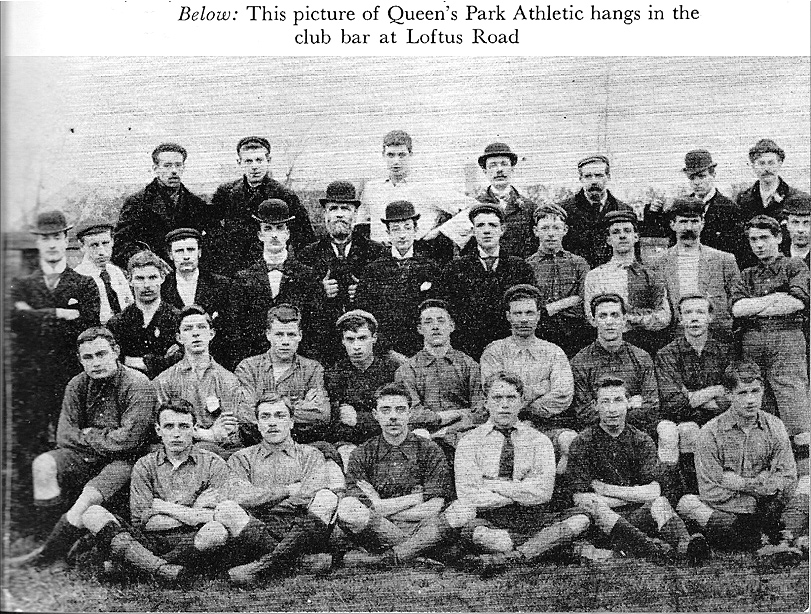 Fig 15. Queen's Park Athletic
Fig 15. Queen's Park Athletic
|
| The common history with the runners of Queen's Park Harriers
|
St Jude's Athletic club is also documented in the history of the sister club Queen's Park Harriers. But there are two different versions. In a newsclip Fig 16 from 1926 it's said that Harriers broke away from St Judes Institute in 1887 while Rangers remained for another year as a football club with the name St Judes Institute FC. It is true that the Rangers broke away the following year, but according to a news clipping from January 1889 Fig 18, the outbreake of the Harriers is two years later 1889. According to this history, St Jude's Institute AC would have only lasted one season.
According to the most recent history of the Queens Park Harriers Fig 17, it was the Rangers who broke away in 1886 and the Harriers who followed in 1887. In both versions, the year of the outbreak for the Harriers are wrong. It is 1889 and not 1887. This can also been comfirmed by the clip from 1888 when the Athletic club is still running.Fig 19
Football and running seem to have gone together. When the St Judes Institute Athletic club is formed 1886 Fig 12 the sports in the institue are named: football, lawn tennis and cricket.The runners are within the football.
Football and running seeed to be close together, and thats the fact in several football clubs. This is why the official name is Queens Park Rangers Football and Athletic club. Attaching a clip also from 1891 where there are runners under the name of Queens Park Rangers.Fig 20.
| 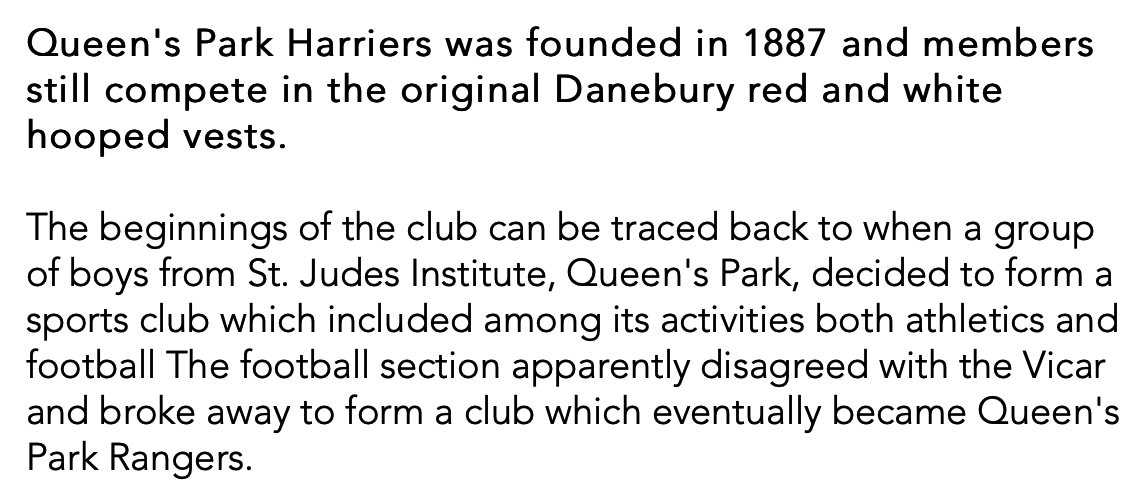
Fig 17. History of Queen's Park Harriers from 2020.

Fig 17b. Queen's Park Harriers crest. |
|
| |
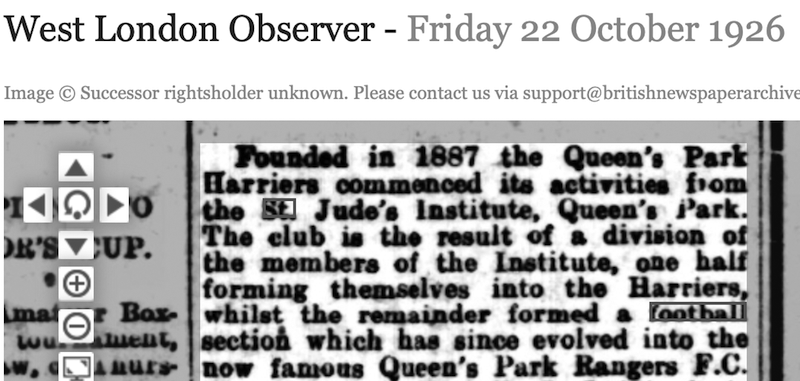
Fig 16. History of Queen's Park Harriers from 1928.
| 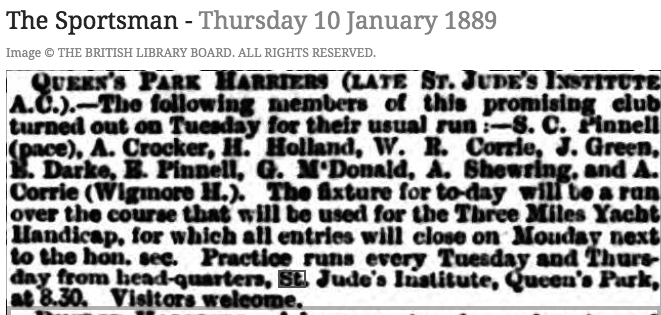
Fig 18. Queen's Park Harriers 1889 (Late St Judes Institute AC).
|
 Fig 19. St Judes Institute AC. Two Famous fotboller is working for the runners in the club: Handicapper J. McDonald ans Starter F. Weller. Fig 19. St Judes Institute AC. Two Famous fotboller is working for the runners in the club: Handicapper J. McDonald ans Starter F. Weller.
| 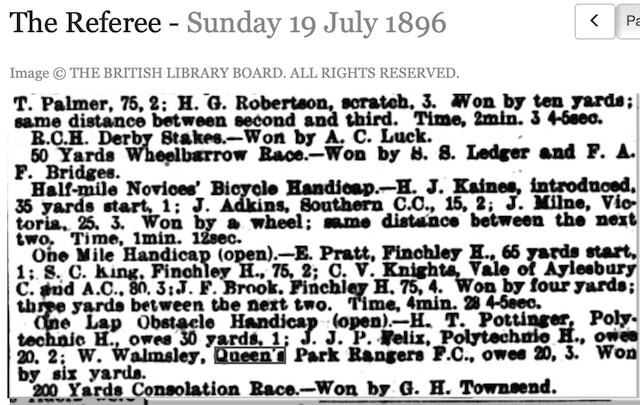
Fig 20. Runners 1896. Among them W Walmsley, Queens Park Rengers. |
| Overall Conclusions
|
The current history is basically based on Wood's history from 1905. Wood does not write anything that happened before he became a supporter of the club as a boy in 1886 or1885, a year which he himself indicates as the beginning of the club.
Other sources that describe events for the time before 1885 provide an exciting but partly contradictory development. Data on years are few and are actually quite uncertain. There are several sources for the origin of the club. The Fig 21 on the right shows the most likely scenario for the year and name, but I have also added alternative developments.
The source that surprised the most and describes the most likely development for the club in the early days is the submission from C.J. Young in Letter to Letter, West Ham's program in 1973. Had this story been the sole source, it would have been seen as quite insignificant. But there is support for his data. For the actual formation of the club, there are four other sources that support Young's story. For the name Queens Park Athletic there is one source, the old club photo. There is also the information about John Wrightsson in a contemporary news clip that describes his retirement greetings.
There are many who have been credited with founding Queens Park Rangers: the church via St Jude's Church, the Principal of Droop Street School, teachers such as John Wrightson but also other clubs such as Christ Church Rangers. There will be another chapter on the latter: The Complicated Merger Issue.
When Teagle, Hiscox, Mckenzie and Webb collect the facts for a history of the club, the story is about a club started by the boys themselves because they wanted to play football. It is in a London dominated by Rugby and Cricket. Although the grounds, the names and the organization have changed and the collaborations: the school, the church, the athletics, other clubs, it has always been the same club from the beginning in 1882, to the professional football club in 1898. That is why it is important to keep this story alive, a way to remember West London's football pioneers. It's something that not all clubs have.
| 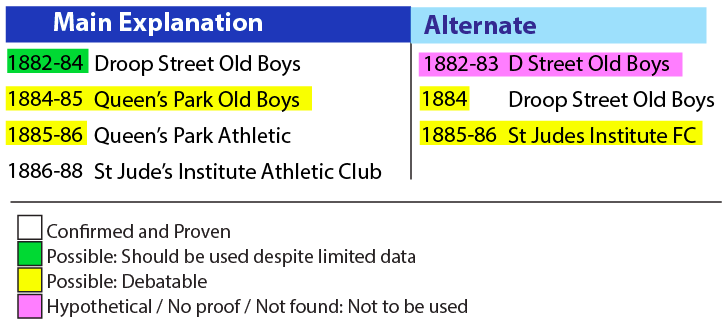
Fig 21. Conclusion with alternate explanations.
The left column shows what I see as the most likely evolution of the club. Colored sections are uncertain. See legend. The most uncertainties are the years. The club can hardly have been formed much later than 1882 as the key players left the school as early as 1880/81.
|
There are opinions that the earliest club, Droop Street Old Boys, did not have sufficient organization to been called a football club. This can be objected with the following:
- It wasn't just the boys, but had the help of teacher John Wrightson who came up with grounds.
- The players themselves did not think so, when they wrote the club history.
- Such reasoning diminishes west London's football pioneers
- With such reasoning, there are many football clubs in England that have to change their history like Dial Square, Newton Heath LYR F.C and more.
|
| St Jude's Institute Matches
|
The 1886-87 season, the St. Judese Institute probably took the step up from junior club to adult team with youthful touch. There were no unusuals with young players in the 1880s English football matches. The club is only included in one newspaper clip, namely in Sporting Life 15 January when Orkney Rovers have sent in that one should play at Welford's Home Farm against St. Jude's Institute. Change of clothes at the institute itself. Fig 22
Next season 1887-88 there are three notes about the St. Jude's Institute. The club advertises when they had open dates for matches. St. Jude's Institute has three players in a combination match organized by the West London Association with players also from Oakland (Shepherds Bush), Fulham St Andrews and Sydney (possibly from Chelsea). Then Aldenham Institute comes to visit. Fig 23 - 25.
There were many clubs named St Judes in London. It is a parish name. More recently, they added place or grounds name in parentheses to separate the differnt clubs. During the 1880s there were St Jude's teams in the north: Edmonton, Hackney, Crouch End. East: Walthamstow, Mildmay Park. South: Gray's Inn Road, Camberwell. West: Hampstead, Primrose Hill. At those time writers were careful about the naming because there were many teams with similar names. I have never seen St. Juda's Institute called only St. Judes in contemporary writing.
There are examples of St Judes who could be an early St. Juda's Institute. Both are from february 1886 before the Atheltic Club. Vulcans (Willesden) third team defeats in February 1886 a St Judes with 2-0. Vulcan was one of West Londons best team and the third team could beat a junior team. There is also a match Sydney against St Judes, which is played played in St Jud'es home at Kensal Green which is interesting. This could be an early team of St Judes. Could also be Hampstead St Judes also. The team Sydney team iis probably from the pub Sydney in Chelsea. Sydneys Albert Morris will later play as the team captain in QPR. Fig 26 - 27. |

Fig 22. Orkney Rovers - St Jude's Institute
| 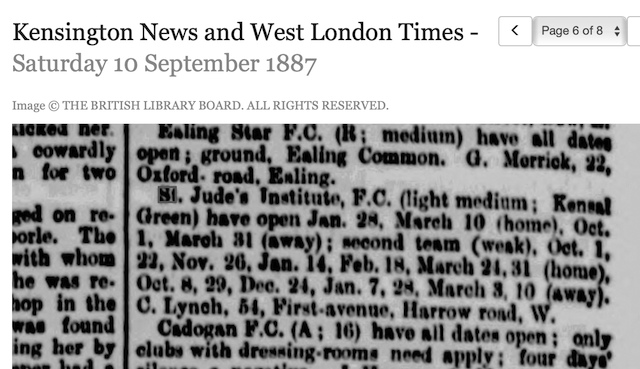
Fig 23. St Jude's Institute open dates
|
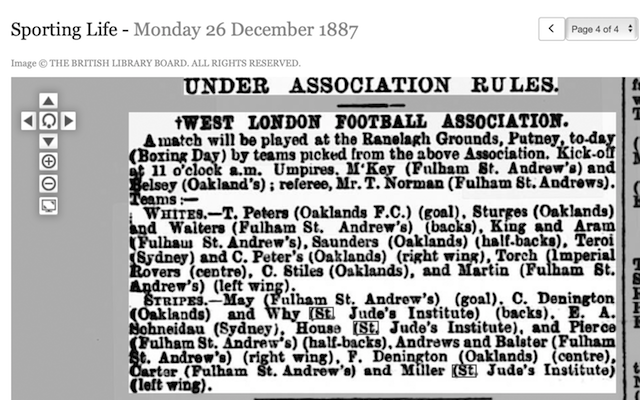
Fig 24. Whites - Stripes, WLA
| 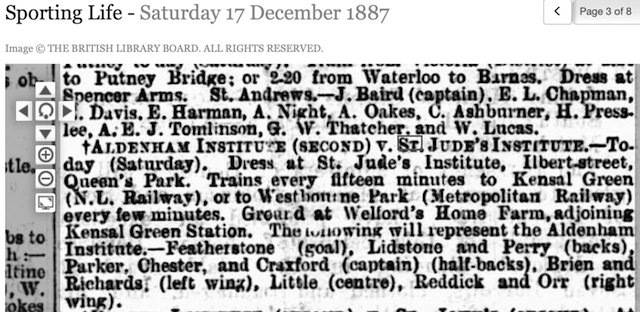
Fig 25. Aldenham Institute - St Jude's Institute
|
| St Judes FC matches 1886. Could be an early name for St Jude´s Institute but it's not proven. Could be St Jude's (Hampstead) |

Fig 26. Vulcan - St Jude's 4-0, Willesden Chronicle.
| 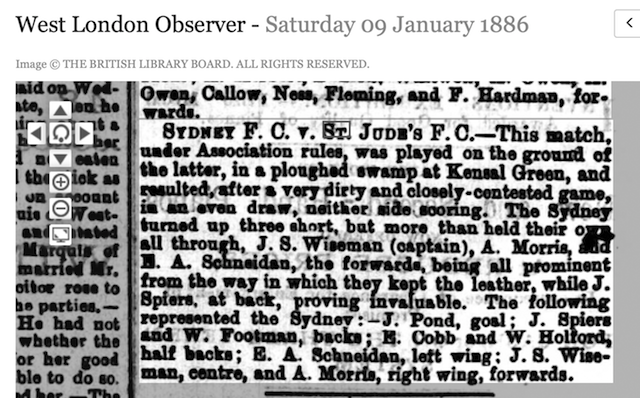
Fig 27. Sydney FC- St Jude's FC 0-0
|
